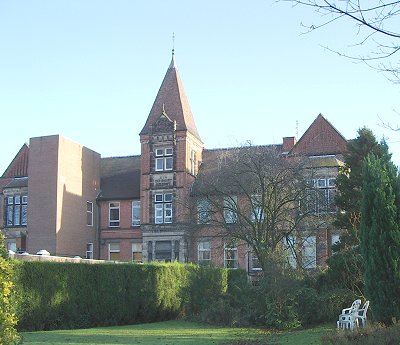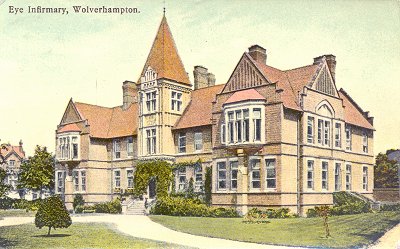|

Local Listing: The original Infirmary was designed by the architect T H Fleeming
(1849‑1935) whose works also include Barclays Bank, Lichfield Street (1876), the
College of Adult Education, Old Hall Street (1899) and the late 19th century
spire of St. Jude's Church, Tettenhall Road (itself built in 1867‑9), all of
which are Grade II Statutorily Listed Buildings, and the former Higher Grade
School, Newhampton Road which is on the Council's Local List.
The Infirmary was built by Wolverhampton builders Henry Willcock & Co.
at a cost of £13,000 and opened in 1888, providing three men's and three women's
wards with thirty beds and five children's cots. A significant part of the cost
was met by local philanthropist, Philip Horsman, who also donated the Art
Gallery to the town and whose benefaction is commemorated in the Fountain in St.
Peter's Gardens.
It is constructed of red brick with elaborate brick details and stone
dressings. It is built to an irregular plan in a simple Gothic style under a
plain clay tiled roof with crested ridge tiles and two spired turrets, one of
which has an inscribed stone plaque bearing the legend: "EYE INFIRMARY AD 1887.
Some of the original sash windows have been replaced and late 20th century
extensions to the original west front have detracted from the character and
appearance of the original building.
Comment: There are three principal buildings on this site: the original Infirmary
of 1888; the Nurses' Home of 1927; and the Outpatients'/Accident
and Emergency Extension of 1937. These buildings are quite
different in style but all are of definite architectural and
historic interest and all were designed by significant local
architects.
|

The infirmary as it was originally, from a
postcard of about 1900. |
All three buildings are locally listed and all are in the Oaks
(Merridale Road) Conservation Area.
The notes under “Local Listing” above are taken from the
Conservation Area Appraisal and are therefore somewhat more
comprehensive than the usual local listing notes.
A full history of the Infirmary can be found on this site
if you
follow this link. It will be apparent that the Eye Infirmary has been very
important in the social and health history of the city.
It has been a greatly appreciated facility in which there
was a good deal of local pride.
|
The local health care trust decided, in 2004, to close the Eye
Infirmary, sooner rather than later, and move its services to
somewhere else, unspecified and apparently unknown.
These buildings are, therefore, at risk and sympathetic
new uses need to be found for them.
As the grounds in which they stand are now crowded and
suffering from poor landscaping and neglect, any re-development
should be treated as an opportunity to greatly improve the
setting of these buildings.

|